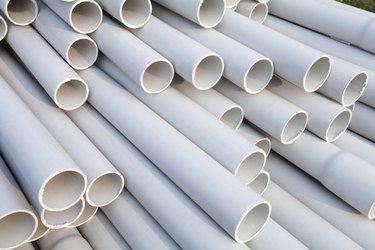
Since the 1950s, plastic water pipes have been the material of choice for plumbers and home builders. Easy to install and economical, plastic plumbing pipes are commonly made from polyvinyl chloride (PVC), chlorinated polyvinyl chloride (CPVC) and polybutylene (PB). Safety concerns surrounding these materials have lead to the development of alternative materials such as high-density polyethylene (HDPE) and cross-linked polyethylene (PEX).
Polyvinyl Chloride
Video of the Day
A study printed in the "Journal of Environmental Engineering" found that, in homes built before 1977, installed PVC pipes were found to leach polyvinyl chloride into drinking water at levels above the maximum allowed contaminant level. Levels were tested at dead-end pipe segments, where water stagnates. The study recommends installation of manual or automatic flush valves to reduce concentrations.
Video of the Day
Phthlates
The Centers for Disease Control (CDC) notes that PVC contains phthalates, which can leach from plastics and, in animal studies, demonstrated the capacity to cause liver and reproductive system damage. The CDC warns that short-term exposure to phthalates shows little toxicity in adults; animal studies indicate that continuous exposure to phthalates is toxic, even at low doses. Infants, in particular, do not process phthalates well.
Safety Standards
Newer plastic plumbing components are marked to show that they meet the current standards for potable water. Compliant pipe is stamped with the codes NSF-PW or NSF-61, ensuring that these pipes meet the American National Standards Institute (ANSI) standards for potable or drinking water. This standard evaluates the contaminants or impurities of materials that come in contact with drinking water.
Manufacture and Disposal Concerns
The manufacture and disposal of PVC creates potent environmental toxins. Polyvinyl chloride, the main ingredient of PVC pipe, is classified as a known human carcinogen. Stabilizers and plasticizers used in PVC production may contain lead or other heavy metals, and during incineration—a common form of disposal—hydrochloric acid is released. Hydrochloric acid is corrosive and can cause respiratory damage. This is also a problem during building fires, where exposure to burning PVC puts firefighters at risk.
Alternatives
According to the Global Development and Environment Institute at Tufts University, up to 70 percent of homes in the United States have PVC piping. Many communities are moving away from PVC piping, choosing instead to use HDPE or PEX.